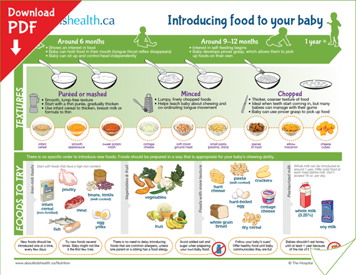You can begin introducing your baby to solids at around six months of age. By about nine to 12 months of age, your baby will show signs that they are ready to feed themselves.
You may have noticed that your baby can start to pick up small objects such as toys and food using their thumb and forefinger. Developing this pincer grasp is a major milestone for your baby. They may soon be ready to hold a spoon and take part in feeding with you.
You will see that your baby can gradually pick up small bits of food like O-shaped cereal or cut-up pieces of toast. They can chew these foods with their gums and safely swallow them.

Your baby's feeding cues
Feeding your baby is an active process that you and your baby do and enjoy together. It will take time for your baby to feed themselves on their own. The key is to share this special time with your baby by following their cues and abilities. It may take some time for your baby to understand what to do with the spoon of food in their mouth or how to chew and swallow solid food. Be patient. You baby may take a few weeks to really understand the idea of eating.
Never force feed your baby. Babies are very good at regulating the amount of food and fluid they should have. They may go through phases when they want to eat more and other phases when they want to eat less. Respect your child's wishes. Your job is to provide healthy, nutritious food and model good eating patterns. Your job is not to make your baby eat. It is important that your child enjoy food and enjoy mealtimes.
Babies who show an interest in food may watch intently as you eat, grab your food or utensil or open their mouths. Once your baby is into a routine of eating solid food at mealtimes, you may discover they prefer some tastes or textures to others. Sometimes you need to offer a food 10 to 20 times on separate occasions before your baby or child will try it. Your child will be more likely to try a new food if they watch you eating it.
Safety issues
Babies need to be closely supervised by an adult while they are feeding. Your older children may enjoy helping to feed your baby, but they may not realize what textures are appropriate for your baby or recognize the signs of choking. Do not let older children feed a baby or young child unless closely supervised by an adult.
Dealing with messy mealtimes
Babies enjoy touching their food and they do not always get everything into their mouths. Feeding babies is certainly a messy time. Do not sweat it when food spills and falls on the highchair or floor. As your baby's co-ordination improves, they will eat more and leave less behind. A splatter mat may help.
